| Robert Montgomery
(Inspiration)

- by Néstor G. Acevedo (Greg) - |
|
INTRODUCTION |
Robert Montgomery (1904 - 1981). The All American Playboy Handsome and Debonair. An MGM star for nearly two decades. Favorite leading man of, Norma Shearer. Motion Picture union leader, Decorated Naval Officer, and Authentic War Hero. Film producer and director. Television pioneer, father of a famous TV star, Elizabeth Montgomery, better remembered thanks to her TV Sitcom, BEWITCHED. All of the above describe Robert Montgomery. He was a formidable man, who accomplished much in his lifetime. Robert Montgomery, born Henry Montgomery, Jr, May 21,1904, in Beacon, New York. Montgomery as screen image, is of a suave sophisticate, who moved with ease in upper class circles, the role came naturally to him.
In the 30s Robert Montgomery was MGM's resident all American Playboy, steering the studio's Great Ladies through a series of glossy light comedies, and drawing room dramas. No one was more sleekly groomed, when playing an air-express pilot in, Night Flight, 1932, he wore evening dress under his flying clothes, or had a more persuasive way with smooth seducers, and cowardly scions, of the Park Avenue set. Signed by MGM in 1928, he worked continuously for the studio until 1941. He was often cast in English roles, notably in Privates Lives, (1931) and Busman's Honeymoon (1940) as Dorothy L. Saver's aristocratic sleuth, Lord Peter Wimsey. By 1937 Montgomery was chafing at his ladies' man image.
After The Last of Mrs. Cheyney 1937, his six film with Joan Crawford, he badgered MGM into giving him the part of the homicidal maniac, Danny, in Night Most Fall 1937, the studio didn't want him in the picture, thinking his portraying a murderer would damage his popularity, Louis B. Mayer, predicted failure when Montgomery fought for the role. Mayer was wrong. The adaptation of Emylin Williamsa stage thriller, proved a personal triumph for Montgomery. It was a considerable critical, and commercial success. Montgomery, one of the studio's most promising actors, had been featured recently opposite Norma Shearer (The Divorcée), Joan Crawford (Our Blushing Brides) and Garbo (Inspiration)
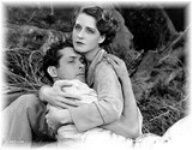 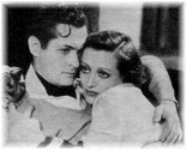 
With Shearer, Crawford and Garbo
GARBO-MONTGOMERY-INSPIRATION |
Inspiration, was Garbo's sixteenth film, and was the only in which Robert Montgomery played opposite Garbo. Inspiration, started filming on October 15 1931, Clarence Brown was directing his third Garbo film in a row. William Daniels again in camera, Garbo had approved Robert Montgomery as her leading man, after seeing him in Norma Shearer, and Joan Crawford Films. Eager to impress, Garbo's new leading man wore a new blue suit, white shirt, and tie on the first day of filming, Greta did not seem to notice.
 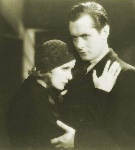
At twenty-six, the tall, athletic, and intelligent Montgomery was a far more promising presence than Garbo's last leading man, but he was soon constrained by the part of André. There was no way he could bring complexity to a spineless, self-contradictory cipher. Garbo insisted on keeping her distance from him, and whatever chemistry might have existed between them, was diluted in a series of foolish dialogue.
Years later, Montgomery would be credited with the opinion that “Making a film with Garbo does not constitute an introduction.” As was true of the most of her costars, from Ricardo Cortez to Melvyn Douglas, few men felt that they knew Garbo any better on the last day of production than they had on the first. Most likely, part of the problem on Inspiration was that Garbo and the director Clarence Brown were at odds. According to Wilhelm Sörensen (who had not yet left the scene.) Greta again felt that she had been talked into doing a picture she did not like-and she had been tired of Clarence Brown, whom she though old-fashioned.
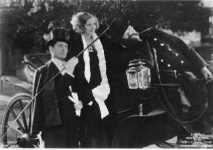 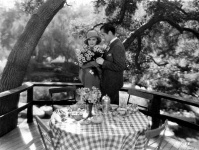 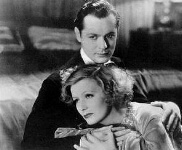
With Garbo Inspiration 1931
An unnamed crew-member later said: “Garbo did not like her role in 'Inspiration'. She did not like her lines. She did not like working in the picture." Garbo could not be blamed, Yvonne's love for the priggish André was totally unbelievable. Montgomery, who was on his way to being M-G-M best actor, was struggling with lines that would disgrace a high school play. Was this the best that the studio could do for its queen?
On November 18, on the set of Inspiration, Garbo and Montgomery sat in front of a false fireplace and waited for artificial snow to start falling outside the windows of the set. A makeup artist touched up Montgomery's face. “Don't you think, Miss Garbo, that this is a silly occupation for a man?” he asked. “Yes I do,” she replied. The snow finally began to fall, and she contemplated having to speak more ridiculous dialogue. “I am very tired,” She said to no one in particular. “Very, very tired.” Six days later, the production was shut down. Inspiration was released on 1931. Robert Montgomery was considered again as Garbo lead man in a next project, Mata Hari , but Ramon Novarro was choose instead. Inspiration was the only Montgomery film that played opposite Garbo.
WHAT THE CRITICS SAID ABOUT INSPIRATION
New York Times |
Miss Garbo, no matter what may be said of the story, gives a stunning performance as the girl who is the toast of Paris studios… Miss Garbo, endeavors to symbolize Yvonne's mood by different styles of coiffure In the initial scenes her hair is fluffed up at the sides, and subsequently it has more subdued aspect.
Motion Picture |
When Garbo loves, she loves like nobody's business. In Inspiration, she loves Robert Montgomery to the extent that she is willing to sacrifice her own happiness, and her own future, to let him have his childhood sweetheart. The ending is Camille without the cough.
Variety
|
Miss Garbo has never looked or played better than in this picture, a suitable assignment. Replete with heavy love stuff, she plays it easily and convincingly, even contributing a sparkling brief bit of light comedy, and often helping long passages of awkward dialogue, to sound almost real.
Picture Play |
Handicapped by the material provided for her, Greta Garbo still shines with such brightness that it is the Only when the picture is well under way that one realizes the weight and dreariness of her burden. For not even the greatest artist maintains effulgence in the murk of a poor picture. She makes her heroine Sensitive, intelligent, alluring, with a shimmer of laughter like sunshine after an April shower.
 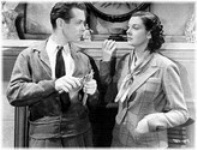
With Ingrid Bergman and Rosalind Russell
MORE ON MONTGOMERY |
While going through the motions at MGM, Montgomery found an outlet for his energies, by becoming active in The Screen Actors Guild. This was a time when motion picture unions were still weak and had to fight an uphill battle against the almighty studios. Montgomery, served as SAG president from 1935 to 1937, and played a part in exposing the Hollywood activities of labor racketeer Willy Bioff.

Despite a measure of popularity, Montgomery was never held in high esteem by MGM, thus the constant casting in poor pictures, and second leads. It took courage for someone as expendable as he was, to assume such provocative role in his union work.

During his life, he would prove that though he may have lacked charisma, he certainly never lacked courage. The outspoken actor fought to break free of the usual roles. When MGM bought Night Must Fall (1937), the studio didn't want him in the picture, thinking his portraying a murderer would damage his popularity. The thriller proved a personal triumph for Montgomery. Night Must Fall garnered outstanding reviews, and Best Actor Oscar nomination for Montgomery.
After World War II broke out in Europe, Montgomery enlisted in London for American field service and drove ambulances in France until the Dunkirk evacuation. Upon Americans entrance into war, Montgomery joined the U.S. Navy and served as naval attaché on British destroyers hunting U-boats. Montgomery took leave from the navy to co-star with John Wayne in the outstanding war picture They Were Expendable, (1945) Directed by John Ford. Following the war, Montgomery again was elected SAG president, but had to resign upon becoming a producer. The ambitious star sought to expand his horizons and persuaded MGM to let him direct a feature employing a novel, and extremely risky, technique. He helmed Lady in the Lake (1946), the film didn't work and effectively ended Montgomery's relationship with MGM. Montgomery turned freelance and continued pursuing behind-the-camera ambitions. Ride The Pink Horse (1947) Would be Montgomery's last outstanding film, as his only completely satisfying directorial effort.
MONTGOMERY TRANSITION TO TV |
Robert Montgomery made the transition to television and succeeded. Robert Montgomery Presents, debuted January 30, 1950, in the Monday night 9:30 to 10:30 slot on NBC and became one of the best know big budget live drama series during the Golden Age of Television. The show won the 1952 Emmy for Best Dramatic Series, featuring his daughter, Elizabeth Montgomery TV debut, and such big name guest stars as, Helen Hayes and James Cagney among others. The show made its final telecast June 24, 1957. Montgomery also produced and hosted the brief 1953 dramatic anthology Eye Witness.
The Gallant Hours (1960) was Montgomery professional swan song. He produced and directed this tribute to Admiral William F. Abullä Halsey, and enlisted close pal James Cagney to portray the naval commander. There were no battle scenes, no romance, and no comic Relief. The films semi-documentary style gave an intimate portrait of a man facing enormous pressure. The Gallant Hours received good reviews for Cagney's performance, but generated little enthusiasm. After leaving television, Montgomery became an outspoken critic of the medium culminating in his 1968, An Open Letter From a Television Viewer. He lashed out, claiming television and radio were controlled by politicians. Montgomery went so far as testifying before Congress on the subject, thus alienating himself from the industry that had given him fame and wealth.
AT THE END |
Montgomery and his wife lived quietly in a posh Manhattan apartment and traveled in the last decade of His life. He slowly faded away to the late show while his daughter became the famous Montgomery. Elizabeth Built on her success in Bewitched, and starred in numerous tele-films of more substance and depth.
 
Montgomery on Radio and TV / Elizabeth Montgomery is Bewitched
Robert Montgomery died of cancer at the age of 77 on September 27, 1981, in New York City. In his lifetime, he met and mastered numerous challenges that would have daunted all but a few. Today he is an obscure figure, but those of us who remember Hollywood Golden Age, will never forget the suave gentleman whose courage was seen not just on the screen, but in his life as well.
|
|
|
SOURCES
Robert Montgomery
A Man of Many Parts by John Roberts,
Edited by Néstor G. Acevedo (Greg) |
| |
| |